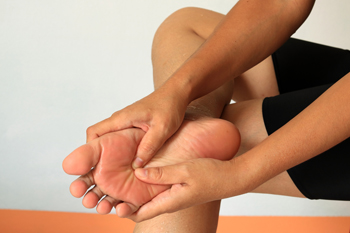
Foot arch pain is often due to prolonged pressure on the feet. Muscles and tendons that support the arches can become fatigued, leading to discomfort, especially for those with an active lifestyle. The most frequent cause of foot arch pain is plantar fasciitis, marked by damage to the thick band of tissue under the foot. It typically develops from altered foot biomechanics, bone spurs, and muscle tightness. Foot cramps, which affect 25 percent of individuals who are 60 and older, contribute to sudden, intense muscle spasms and arch pain. Tarsal tunnel syndrome, though less common, results from pressure on the tibial nerve, causing inner arch pain, pins and needles, and numbness. Plantar fibromatosis involves small nodules in the plantar fascia, causing a firm lump in the arch and pain with pressure. Posterior tibial tendonitis, often the result of overuse during high-impact activities, leads to pain on the bottom of the foot. Stress fractures, commonly caused by repetitive overloading during high-impact activities, result in sharp arch pain with localized bruising and swelling. Additionally, flat feet, where arches collapse, are linked to foot arch pain as well as knee and back pain. Custom orthotics can alleviate discomfort from foot arch pain. For a solution to foot arch pain, it is suggested that you schedule an appointment with a podiatrist.
If you have any concerns about your feet, contact Tanisha Richmond, DPM from Richmond Foot & Ankle, LLC. Our doctor can provide the care you need to keep you pain-free and on your feet.
Biomechanics in Podiatry
Podiatric biomechanics is a particular sector of specialty podiatry with licensed practitioners who are trained to diagnose and treat conditions affecting the foot, ankle and lower leg. Biomechanics deals with the forces that act against the body, causing an interference with the biological structures. It focuses on the movement of the ankle, the foot and the forces that interact with them.
A History of Biomechanics
- Biomechanics dates back to the BC era in Egypt where evidence of professional foot care has been recorded.
- In 1974, biomechanics gained a higher profile from the studies of Merton Root, who claimed that by changing or controlling the forces between the ankle and the foot, corrections or conditions could be implemented to gain strength and coordination in the area.
Modern technological improvements are based on past theories and therapeutic processes that provide a better understanding of podiatric concepts for biomechanics. Computers can provide accurate information about the forces and patterns of the feet and lower legs.
Understanding biomechanics of the feet can help improve and eliminate pain, stopping further stress to the foot.
If you have any questions please feel free to contact our office located in Dayton, OH . We offer the newest diagnostic and treatment technologies for all your foot and ankle needs.